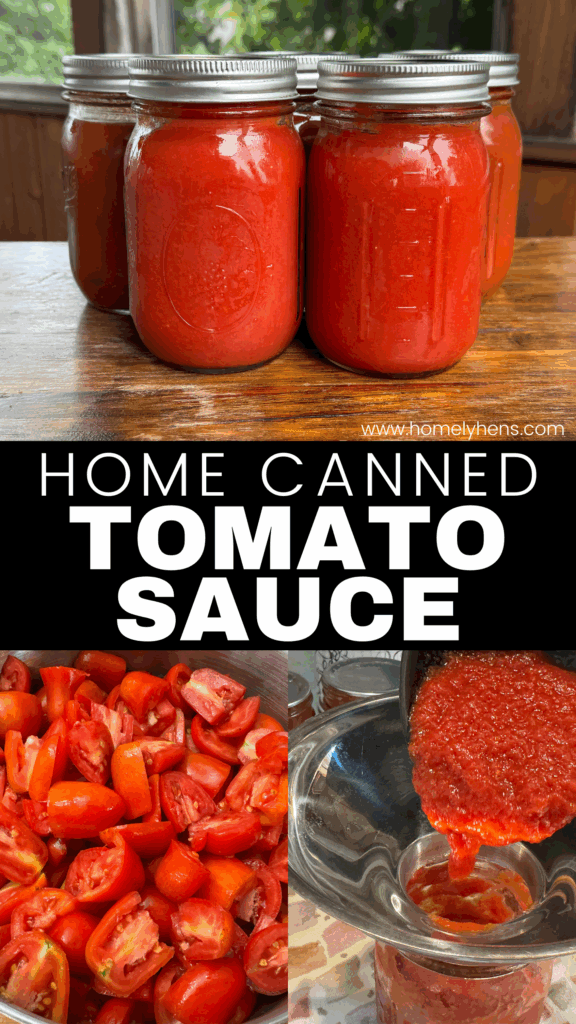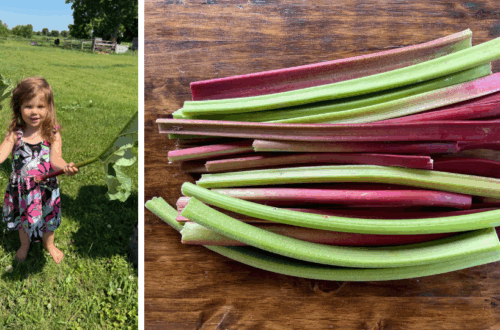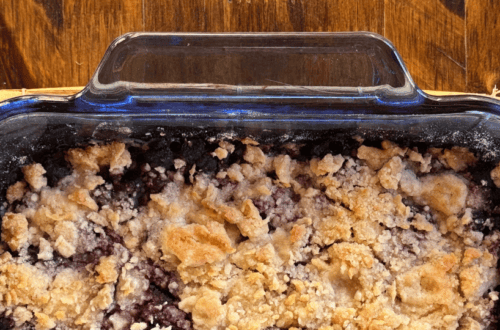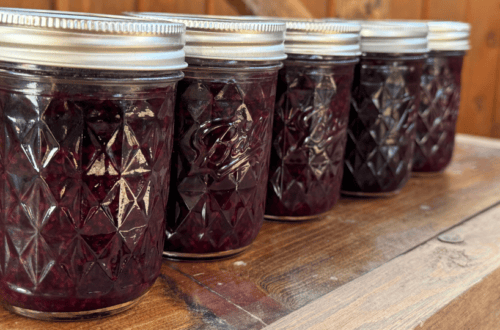How to Can Tomato Sauce (Two Different Methods)
Homemade canned tomato sauce is the ultimate way to capture the rich, fresh flavor of summer tomatoes for year-round cooking. Whether you prefer a smooth, seed-free sauce or a blended version, learning how to can tomato sauce at home gives you full control over the ingredients and the taste.
In this post, you’ll find two simple methods for preparing tomatoes, along with step-by-step canning instructions to make the process easy and safe.
For more water bath canning ideas, check out my full Water Bath Canning Page.
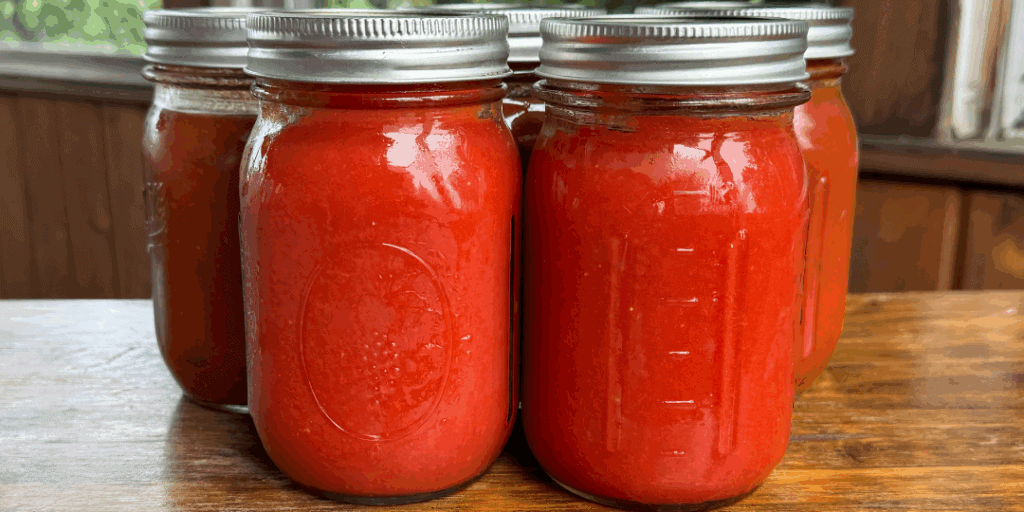
This post contains affiliate links. This will not cost you anything, but will help us offset the cost of running the blog. We only share products we use and would recommend to a friend. Thank you for your support! Click ‘HERE’ for more info.
Quick Summary
- Wash and quarter fresh tomatoes.
- Cook until softened, then run through a food mill.
- Simmer to desired thickness.
- Add lemon juice to jars.
- Fill jars with hot sauce, leaving headspace.
- Process in a canner according to directions.
Why Make Your Own Canned Tomato Sauce?
Making your own tomato sauce has the same great benefits of any other homemade food. It’s fresh, customizable, and you have total control of the ingredients – no extra preservatives or ingredients you may not want.
You’ll save money making your own tomato sauce and anything that’s made from it, like pizza sauce, marinara, etc. You’re also being more sustainable when you grow your tomatoes or supporting local farms if you buy your tomatoes when they’re in season locally.
I also really think it’s fun to grow and can my own food. It’s a lost art these days, and learning more about being self-sustaining and in control of what my family eats is important to me!



Best Tomatoes for Canning Sauce
You can make tomato sauce with any tomatoes! The type will affect the flavor and consistency. Using paste varieties like Roma, San Marzano, or Amish Paste tomatoes are more meaty and will reduce the cook time. They aren’t quite as juicy, so there won’t be as much water to boil out.
Using a mix of paste tomatoes and slicing tomatoes (Beefsteak, Brandywine, or Cherokee Purple) can be beneficial, too. The slicing tomatoes tend to have more juice, sweetness, and acidity, which adds brightness and complexity to the sauce.
A mix makes the sauce taste richer and less one-dimensional. When you use a mix of tomato varieties, you can also just use whatever is ripe in your garden right now, vs feeling like you have to wait for all your paste tomatoes to ripen before you make your sauce.
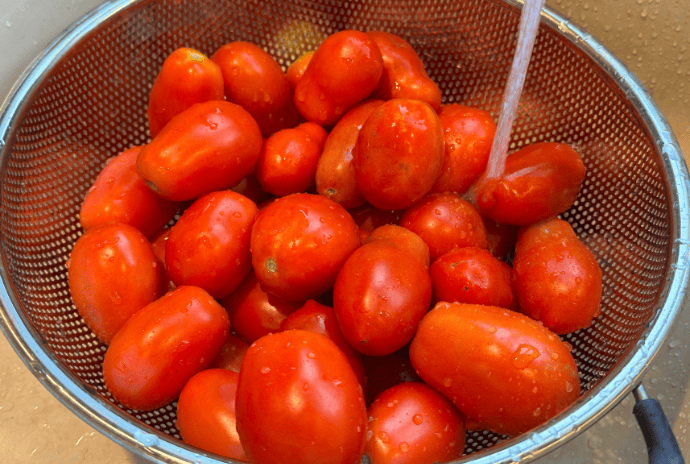
Ingredients & Equipment You’ll Need
- Fresh tomatoes: Ripe, juicy tomatoes are the foundation for flavorful, safe canned tomatoes.
- Bottled lemon juice: Ensures proper acidity to prevent spoilage and make your sauce safe.
- Large stockpot: Perfect for cooking large batches of tomatoes evenly before canning.
- Food Mill: Helps remove skins and seeds for a smooth sauce or crushed tomato texture.
- Gallon Glass Jar with Spigot: If using the blended method, to allow the tomato sauce to separate.
- Canner (water bath or pressure): Necessary for safely preserving tomatoes for long-term storage.
- Canning Tools: Tools to make pouring, lifting, and tightening easier while canning.
- Wide Mouth Stainless Steel Funnel: Plastic-free alternative to other funnels.
- Canning jars, lids, and bands: Essential for keeping your tomato sauce fresh and sealed.
Two Ways to Prepare Tomatoes for Canning Sauce
There are two easy methods you can choose from for making tomato sauce, depending on what equipment you have and your desired texture.
Which Tomato Sauce Method is Best for You?
The food mill method involves cooking the tomatoes briefly and then passing them through a food mill, which removes skins and seeds while producing a smooth, uniform sauce. This method is ideal if you want a classic, silky sauce that’s ready to can immediately, and it’s especially helpful for larger batches because it speeds up the process of straining out the solids.
On the other hand, the blend-and-separate-in-the-fridge method allows you to cook the tomatoes and then blend them with a hand blender or regular blender, leaving some texture if desired. You store the sauce in the fridge for a short period, then separate watery portions before canning.
This method is excellent for smaller batches, or if you prefer to adjust thickness and flavor over a day or two before sealing jars. Ultimately, the choice comes down to whether you want immediate, smooth sauce with a food mill or more control and flexibility with blending and short-term refrigeration.
Food Mill Method
Wash and quarter fresh tomatoes. Cut any bad spots off. Add all the tomatoes to a large pot and cook on medium heat until they have softened, about 20 minutes. Stir often so the tomatoes don’t burn to the bottom of your pot.
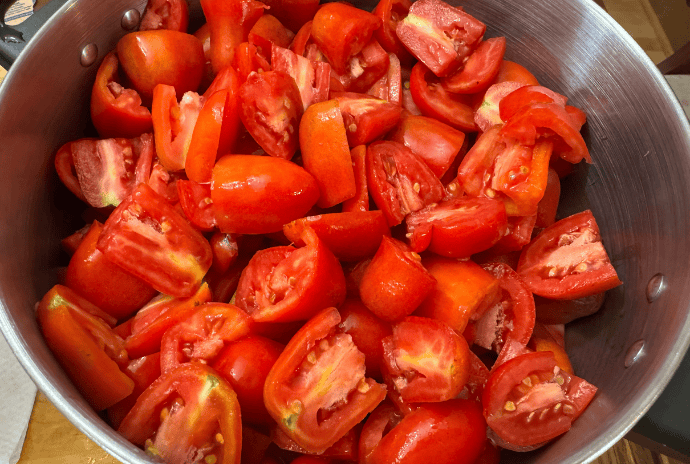
Ladle the soft tomatoes into the food mill and process so the skins, core, and seeds are separated. Collect the sauce in one pot and the skins and scraps in another. Discard the scraps into your compost or save them to add to broth or to dehydrate into tomato powder.
Pour the sauce back into your large pot and simmer until it has reached your desired thickness, 1-2 hours.
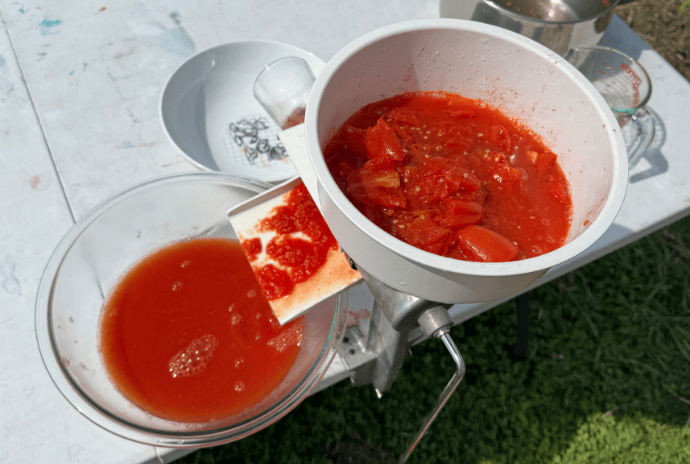
Blender and Fridge Method
Wash the tomatoes and cut off any bad spots. Add tomatoes to a pot and heat on medium until they release some juices. Turn the heat to medium-high and bring the tomatoes to a boil.
Once they’ve boiled (and any bacteria have been killed before canning), blend the tomatoes. Work in batches and add the tomatoes to a blender, and blend until smooth. You can also use an immersion blender and blend right in the pot. Leaving chunks if you’d like.
Put the sauce into a large glass jug with a spigot at the bottom and put it in the fridge for at least 8 hours, or overnight. The water will separate from the rest of the tomato sauce and sink down to the bottom. Take the jug out of the fridge and, using the spigot, pour the water out, leaving you with thick sauce.
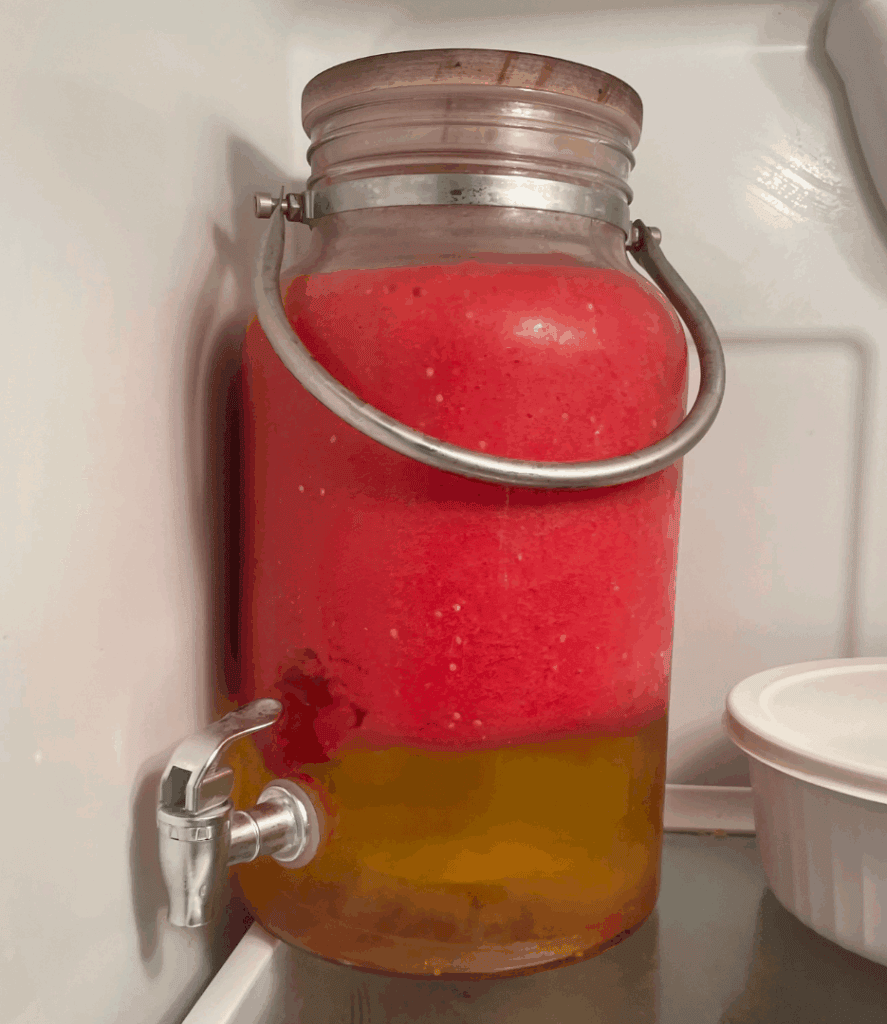
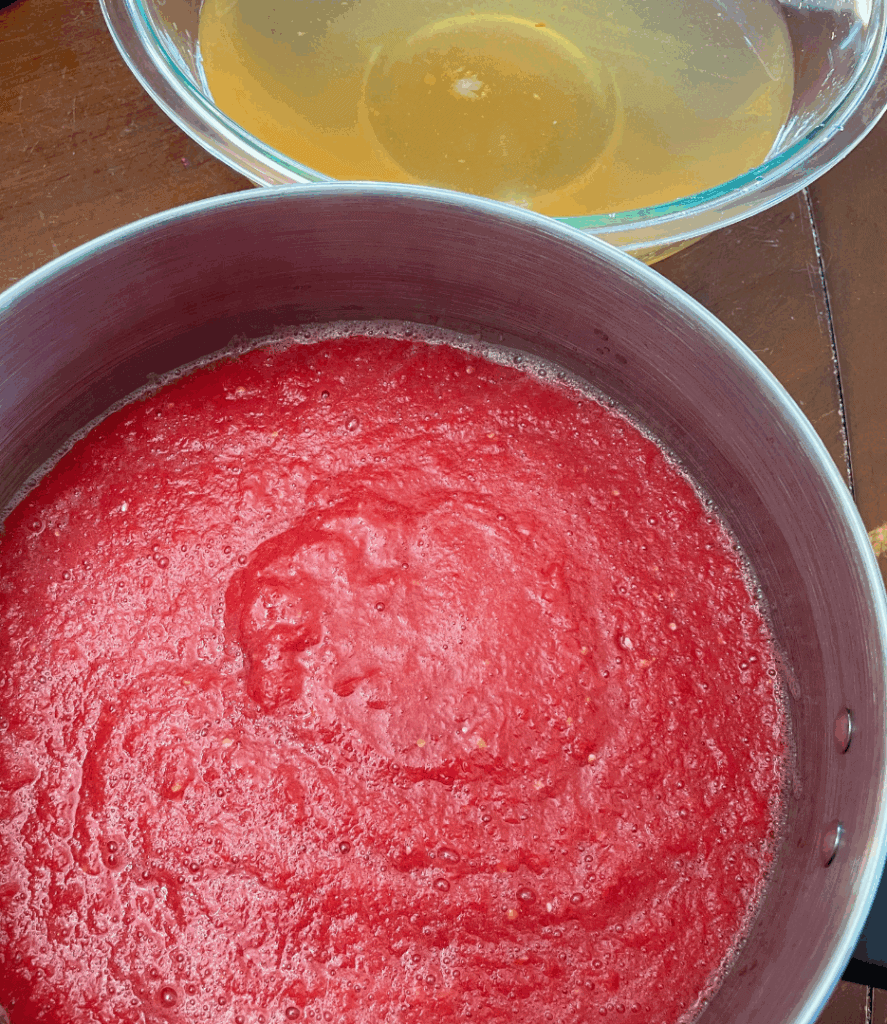
If your jug doesn’t have a spigot, you can ladle the thick sauce out from the top, leaving the water at the bottom.
If you want a thicker sauce, add your sauce to a pot and reduce on medium heat until it is your desired thickness. This won’t take as long because most of the water is already gone.
Water Bath Canning Instructions
Prepare your water bath canner by adding water, and start to heat the water. Clean the jars and heat them on low in the oven or by rinsing them with hot water so they’re hot when you add the hot tomato sauce.
Add 2 tbsp of lemon juice and the optional 1 tsp of salt to each quart-sized jar (1 tbsp lemon juice and 1/2 tsp salt for pints).
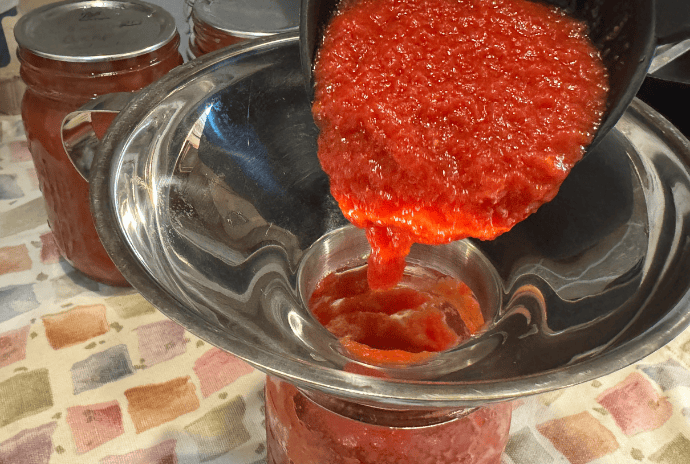
Fill hot, clean jars with the hot sauce, leaving 1/4 inch headspace. Wipe rims, apply lids and rings fingertip-tight
Add the jars to hot water in the canner, and make sure they are covered by 1-2 inches of water. Bring the water to a boil. Process in the boiling water for 40 minutes for quarts (35 for pints). Adjust for altitude.
Once your timer goes off, turn off the canner and remove the lid. Let the jars sit in the water for 5 minutes, then remove the jars using a jar lifter onto a towel and let them sit for 12-24 hours.
After 12-24 hours, remove the rings and check to make sure the jars are sealed. Store with the rings off for up to 18 months in a cool, dry place. If you have jars that didn’t seal, keep the rings on and put them in the fridge to use soon.
Altitude Adjustments for Water Bath Canning
- 1,001–3,000 ft → add 5 minutes
- 3,001–6,000 ft → add 10 minutes
- 6,001–8,000 ft → add 15 minutes
- 8,001–10,000 ft → add 20 minutes
When Should You Pressure Can Tomato Sauce?
Pressure canning is recommended for tomato sauces that include low-acid ingredients, such as onions, garlic, or peppers, or when you want a slightly thicker, heartier sauce. While traditional tomato sauces can be safely processed in a water bath if you add lemon juice or citric acid, using a pressure canner guarantees safety at higher altitudes or when layering multiple vegetables. Pressure canning also reduces the risk of spoilage for sauces stored long-term.
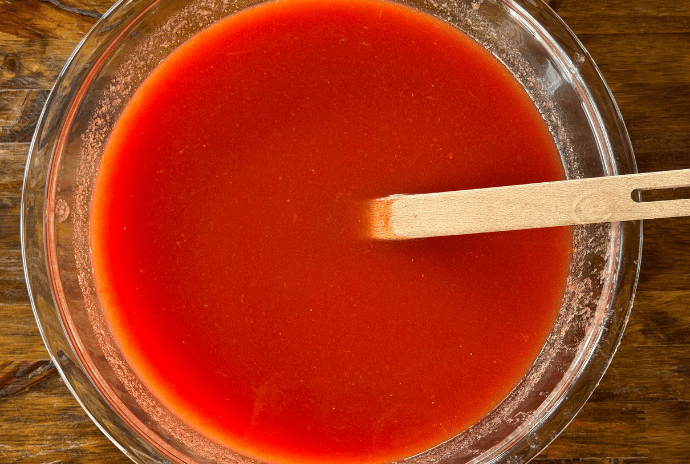
When to Choose Pressure Canning Over Water Bath Canning
Choose pressure canning if:
- Your sauce contains low-acid ingredients like onions, garlic, or beans.
- You want to ensure safety at altitudes above 1,000 feet (or your recipe specifies it).
- You are making larger quantities and want to reduce spoilage risk.
Use water bath canning if:
- Your sauce is primarily high-acid tomatoes and you’ve added lemon juice or citric acid.
- You prefer a simpler method and are storing jars for a moderate period.
Pressure Canning Processing Times for Pints & Quarts
Processing times depend on the technique and jar size. For pressure canning tomato sauce (0-1,000ft):
- Pints: 25 minutes at 10lbs psi
- Quarts: 30 minutes at 10lbs psi
Pressure Canning Altitude Adjustments
At higher altitudes, water boils at a lower temperature, so pressure must be adjusted:
- 1,001–3,000 ft → add 5 psi
- 3,001–6,000 ft → add 10 psi
- 6,001–8,000 ft → add 15 psi
Check your pressure canner’s guide for exact recommendations.
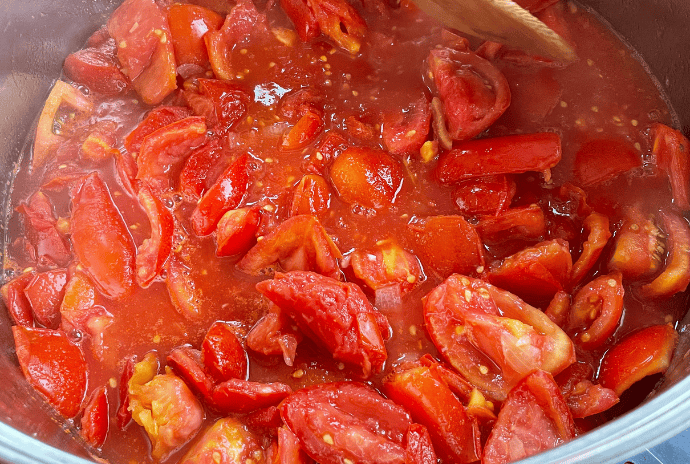
Safety Tips for Canning Tomatoes
- Always use fresh, high-quality tomatoes. Avoid overripe or damaged fruit.
- Clean jars and lids before use, and check for cracks or chips.
- Add lemon juice or citric acid to each jar if using a water bath.
- Wipe rims clean before sealing to prevent jar sealing issues.
- Follow tested processing times exactly—do not shorten them.
- Allow jars to cool undisturbed for 12–24 hours before checking seals.
How to Store Your Home-Canned Tomato Sauce
Storing freshly canned tomato sauce is easy! Take the rings off after about 24 hours to make sure the lids do not come off when pulled gently. Keep the rings off and store them in a cool, dark place for up to 18 months.
How to Use the Tomato Sauce
Tomato sauce is a versatile ingredient that’s used in many recipes! From soups to tacos, on spaghetti or in your favorite chili! Check out some of these recipes where you can put your tomato sauce to work.
- Taco Chili: A hearty, flavorful chili with a Mexican twist that’s perfect for weeknight dinners.
- Pasta Bake: Cheesy, comforting, and easy to prepare—ideal for feeding the whole family.
- Minestrone Soup: A fresh, veggie-packed Italian classic that warms the soul and stretches your garden harvest. Use this tomato sauce to make your own pasta sauce for the soup.
- Taco Bake: All the flavors of tacos in a simple, baked casserole your family will love.
- Hot Pockets: Savory pockets filled with your favorite ingredients, perfect for a quick, homemade lunch or snack.
Explore More Canning Recipes
Grab a few more vegetable recipes to can during this gardening season. Combine them altogether for soups, stews, chilis, and more to enjoy all year!
Common Tomato Sauce Canning Questions
Here are a few common questions that come up. I hope you find them helpful, and if you have any other questions, please let us know!
Yes, you can add herbs, onions, or peppers, but there’s a safety consideration: adding low-acid ingredients like onions, garlic, or peppers lowers the overall acidity of the sauce. If you include them, it’s safest to use a pressure canner instead of a water bath to ensure the sauce is shelf-stable and safe from bacteria like botulism.
Tomatoes are borderline acidic, and acidity is what prevents harmful bacteria from growing during water bath canning. Adding lemon juice or citric acid guarantees the sauce stays safely acidic. This step is essential if you are water bath canning, but not necessary if you are using a pressure canner with low-acid add-ins.
Yes, but thaw them first and drain any excess water. Frozen tomatoes release extra liquid that can make your sauce too watery for proper canning. After thawing and draining, proceed with your sauce recipe as usual. Keep in mind that flavor may be slightly milder than fresh tomatoes, so taste and adjust seasonings before canning.
For safe and successful canning, your sauce should be medium-thick, like a typical pasta sauce. It shouldn’t be as thin as juice, because very thin sauces can bubble over during processing or lead to jars losing liquid. If your sauce is too thick, you can thin slightly with water or tomato juice. If it’s too thin, simmer it down to reach the right consistency before filling jars.
Ready to Make Your Own Tomato Sauce?
Now that you know how to safely can tomato sauce at home, it’s time to roll up your sleeves and start cooking! Try this recipe with your favorite tomatoes, experiment with herbs and spices, and enjoy the cozy, homemade flavor all year long.
Share your creations in the comments or tag me on Instagram, I love seeing how your sauce turns out!
Want to feel even more confident with canning? Grab my free Canning with Confidence guide, packed with helpful charts, safety tips, and step-by-step instructions for preserving all your favorite foods.
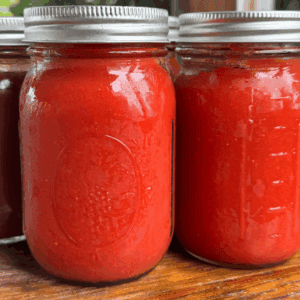
How to Can Tomato Sauce
Equipment
- water bath canner
- Canning Tools
- 6 Pint-Sized Jars, Rings, Lids
Ingredients
- 15 lbs tomatoes
- 2 tbsp lemon juice per quart jar
- 1 tsp salt per quart jar (optional)
Instructions
- Wash and quarter fresh tomatoes. Cut any bad spots off.
- Add all the tomatoes to a large pot and cook on medium heat until they have softened, about 20 minutes. Stir often so the tomatoes don't burn.
- Ladle the soft tomatoes into the food mill and process so the skins, core, and seeds are separated. Collect the sauce in one pot and the scraps in another. Discard the scraps into your compost or save them to add to broth or to dehydrate into tomato powder.
- Pour the sauce back into your large pot and simmer until it has reached your desired thickness, 1-2 hours.
- Prepare your water bath canner by adding water, and start to heat the water. Clean the jars and heat them on low in the oven or by rinsing them with hot water so they're hot when you add the hot tomato sauce.
- Add 2 tbsp of lemon juice and the optional 1 tsp of salt to each quart-sized jar (1 tbsp lemon juice and 1/2 tsp salt for pints).
- Fill hot, clean jars with the hot sauce, leaving 1/4 inch headspace. Wipe rims, apply lids and rings fingertip-tight
- Add the jars to hot water in the canner, and make sure they are covered by 1-2 inches of water. Bring the water to a boil. Process in the boiling water for 40 minutes for quarts (35 for pints). Adjust for altitude (see notes).
- Once your timer goes off, turn off the canner and remove the lid. Let the jars sit in the water for 5 minutes, then remove the jars using a jar lifter onto a towel and let them sit for 12-24 hours.
- After 12-24 hours, remove the rings and check to make sure the jars are sealed. Store with the rings off for up to 18 months in a cool, dry place. If you have jars that didn't seal, keep the rings on and put them in the fridge to use soon.
Notes
- 1,001–3,000 ft → add 5 minutes
- 3,001–6,000 ft → add 10 minutes
- 6,001–8,000 ft → add 15 minutes
- 8,001–10,000 ft → add 20 minutes




